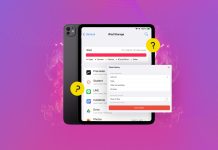 The day has finally come when you can read screenplays on your iPad! Unfortunately for Final Draft, Inc., that day came on April 3, 2010 — the day the original iPad hit shelves.
The day has finally come when you can read screenplays on your iPad! Unfortunately for Final Draft, Inc., that day came on April 3, 2010 — the day the original iPad hit shelves.
I’ve been reading PDFs of my Final Draft screenplays with iOS since before anyone had even heard of the iPad. Granted, this new app offers a few advantages over a PDF, but not enough to make me drop $19.99 and abandon my current Dropbox-centric process.
The Final Draft format
For film industry professionals, Final Draft is the screenplay format standard. I know many writers that don’t use Final Draft to write, but they know that they must be able to convert or export to FDX format, as that’s what most people want to see. Sometimes a PDF will suffice, but Final Draft includes lots of great collaborative, notes, and production features, so working within Final Draft (or something fully compatible) is usually preferred.
iPad enthusiasts have seen the device as a potential content creator from day one, especially in terms of writing apps. After all, screenplay programs are really just glorified word processors. Even those in the film industry who just bought their iPad as a toy have seen that they can do more with it than they thought, and we’ve all been waiting for Final Draft to bring their “glorified word processor” to the iPad in some form.
Final Draft on iOS
After all, reading screenplays have always been accessible on the iPad via PDF, via email, iDisk, or other syncing services (or iTunes File Sharing, if you want to make it super-inconvenient). I use Dropbox to manage all of my production files, and being able to stay in one app to look at overheads, storyboards, and the script is very convenient. Since iOS can’t read the FDX format, a PDF is preferred in this case.
While most of us don’t mind hitting File > Save as PDF, those that must read a lot of scripts on a regular basis find exporting a lot of PDFs to be tedious. An elegant reader app from John August addressed this issue a while ago, and received great reviews here at Macgasm. Also, a handful of Final-Draft-compatible writing apps have been available on the iOS App Store for some time. They import and export to FDX, often imperfectly, but usually good enough to scratch out a scene or script, then send it to the desktop for cleanup.
Meanwhile, we all waited for an awesome app from the official Final Draft, Inc. to raise the bar.
Final Draft Reader
So they teased, and they tested, and they hinted, and they teased some more. Then, last week, Final Draft, Inc. released their long-awaited app for iPad: a reader. Now, I realize some in the industry may welcome this reader and take advantage of its script notes feature as part of their job as a producer or executive. It might even prove useful for some writers collaborating. But it’s my guess that most iPad-wielding filmmakers are disappointed.
As one of the disappointed, my opinion regarding this app is clearly one-sided (more on that in a few). I also should disclose that I’ve not used this app, nor do I intend to. If it works perfectly as advertise, I have no use for it, especially for $19.99. If Final Draft thinks I’ll feel differently after using it, they are welcome to send me a review copy.
So let me first point out that the Final Draft Reader app does have some nice features for a reader app:
It opens the native FDX format, and you can add and edit script notes which remain in the file when sent back to your desktop.
That’s pretty much it.
A functional embarrassment
This whole process should be a total embarassment to Final Draft, Inc. — that they’ve spent this long, held this many focus groups, and spent who knows how much money, and this is all they have to show for it. As a reader, John August’s FDX Reader is just as good or better (though without the ability to edit script notes), and it was done quickly, leanly, efficiently, and humbly. It’s a shame he will likely discontinue development and support now that Final Draft, Inc. has unleashed this disgrace.
The most expensive Final-Draft-compatible screenwriting app on the App Store is $8.99, currently. Yet Final Draft, Inc. wants to charge $19.99 for this featureless wasteland.
I’ve given few scathing reviews in my time here at Macgasm, as many of the apps I review are by small development companies and sometimes just a guy. I try to take that into perspective. But no doubt the harshest review I’ve given was for another app from an industry-standard film company — MMS to Go (read that scathing review here). This release from Final Draft falls into the same territory.
To be fair, here’s Final Draft’s big list of features from their press release.
- Works with Final Draft version 8 FDX files – the Hollywood industry standard script file format
- Imports scripts using email, iTunes File Sharing, or Dropbox
- Perfectly paginates to US Letter and standard European (A4) page sizes
- Precisely displays production scripts, including colored production pages, locked pages, scene numbering, and more!
- Scripts accurately scale to actual draft size
- Add, edit, or delete ScriptNotes
- Automatic bookmarking feature ensures that you pick up right where you left off
- Easily reorder and organize your Scripts List
- Email your script directly from the Final Draft Reader app
- Scripts are viewable in landscape and portrait orientations
- Touch/swipe to turn pages in portrait view
- Scroll from page to page quickly in landscape view
- Quickly scroll through your script by scene or by page using the Page Navigator
- Search your entire script for names, key words, or any text fragments
- Link to online help from within the app
- Toggle navigation controls off for maximum readability
- Version numbers are automatically applied to imported script files that share the same name
- Multi-page Title Pages are supported for TV production drafts
- Print wirelessly with AirPrint*; choose page range, number of copies, and double-sided printing
- Scripts written in 14 different languages appear exactly as they do in the desktop application
Open files from email? Landscape and Portrait orientation? As MMS to Go tried to do, Final Draft lists a lot of things that are really features of iOS. It’s an embarrassing attempt to flesh out a feature list that doesn’t include “writing”.
It’s not that the app isn’t good or won’t be useful for some people in the industry. It’s that it’s so far below expectations, so far behind the technology it seeks to embrace, so broadly amiss from what writers want, Final Draft should at least give it away — certainly not charge $19.99 for it.
Competition is good for everyone
Like the awful, overpriced portable scheduling app, this Final Draft Reader app uses the bloated resources of a comfortably “industry-standard” competition-less company to produce the bare minimum at an exorbitant cost to the end user.
It’s time for another little guy to rise up and get rid of this irrelevant behemoth. For OS X, I use Scrivener, which compiles notes into Final Draft 8 (FDX) format; I highly suggest giving it a look — $44.99. Another great app just for writing is Movie Draft SE — $29.99 — and it includes Final Draft compatible formats and user interface tweaks to help make the switch. For iOS, I have used both Screenplay — $8.99 — and Scripts Pro — $5.99 — which I can use to edit FDX files or create them from scratch. You can buy them all for less than half the cost of Final Draft for OS X. Many have free demos available via their developers’ sites, linked in the paragraph above.
These programs are not without their flaws, but they are strong offerings, affordable, offer different features than Final Draft, and are in most cases version 1 or 2 apps, meaning the future is wide open for development. They are small companies — one or two-man shops in some cases — and they need your support. Only through true competition will real innovation and affordable, professional-quality apps find their way to the top.
If someone uses the Final Draft app and thinks I’m way out of line, by all means let me know.
Source: Final Draft, Inc.
Via: doddlenews






